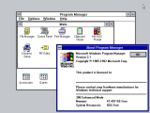Difference between revisions of "Windows 3.1"
m |
|||
| Line 7: | Line 7: | ||
| multitasking = cooperative with paging (386) / swap (286) | | multitasking = cooperative with paging (386) / swap (286) | ||
}} | }} | ||
| + | |||
| + | [[Image:Windows 3.1.jpg|thumb|right|150px|Windows 3.1]] | ||
Windows 3.1 introduced several new technologies onto the Windows 3.0 platform. The most notable was [[True type]] fonts, and OLE. The 'real mode' was removed, as Windows 3.1 now executed in protected mode only. | Windows 3.1 introduced several new technologies onto the Windows 3.0 platform. The most notable was [[True type]] fonts, and OLE. The 'real mode' was removed, as Windows 3.1 now executed in protected mode only. | ||
Revision as of 19:20, 14 April 2010
| Windows 3.1 | |
| Type: | Time-sharing |
|---|---|
| Creator: | Microsoft |
| Multitasking: | cooperative with paging (386) / swap (286) |
| Architecture: | i286, i386 |
| Date Released: | 1992 |
Windows 3.1 introduced several new technologies onto the Windows 3.0 platform. The most notable was True type fonts, and OLE. The 'real mode' was removed, as Windows 3.1 now executed in protected mode only.
Windows 3.1 is more of an 'environment' then an operating system, as it still uses MS-DOS for some functions, and the 386 enhanced mode spawns VDM's with MS-DOS.
Microsoft also included basic multimedia API's facilitating the playback of MIDI files, and wav audio files.
Modes of operation
Windows 3.1 dropped the realmode from Windows 3.0, while retaining both standard & 386 Enhanced modes. Both modes functioned identically as they did in Windows 3.0
| v • d • e Microsoft Windows Versions, Vendors and Related |
|---|
| 16 bit - Windows 1.0 • Windows 2.0 • Windows 3.0 • Windows 3.1 • Windows 3.2
Hybrid 32/16 bit - win32s • Windows 95 • Windows 98 • Windows ME 32 bit - Windows NT 3.1 • Windows NT 3.5 • Windows NT 3.51• Windows NT 4.0 |
